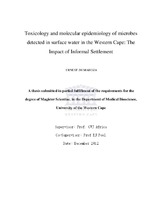| dc.contributor.advisor | Africa, Charlene | |
| dc.contributor.author | Maboza, Ernest J.M. | |
| dc.date.accessioned | 2015-06-03T15:02:22Z | |
| dc.date.available | 2015-06-03T15:02:22Z | |
| dc.date.issued | 2013 | |
| dc.identifier.uri | http://hdl.handle.net/11394/4264 | |
| dc.description | >Magister Scientiae - MSc | en_US |
| dc.description.abstract | Informal settlements are often implicated in surface water pollution with faecal matter. In most
instances faecal pollution in the associated surface waters persists despite improvements in
sewage removal infrastructure. This study evaluates the importance of investigating the water
quality of the Plankenbrug River before it reaches Khayamnandi settlement by comparing water
quality in spring and in winter upstream (Pre-Khayamnandi) and downstream (Post-
Khayamnandi) from the settlement.
In this study, faecal indicator bacteria (Escherichia coli and total coliforms) were enumerated
using Chromocult agar. E. coli was further characterized with analytical profiling index (API)
and haemolysis assays. Both Pre- and Post-Khayamnandi were not significantly different from
each other for both total coliforms and E. coli in winter. Pre-Khayamnandi had between 105 and
108 cfu/100 ml for total coliforms while Post-Khayamnandi had total coliform colony count
between 106 and 107 cfu/100 ml. E. coli also exhibited a similar pattern with slightly higher
counts at Post-Khayamnandi with colony counts from 104 to 107 and 105 to 107 cfu/100 ml.
Spring microbial count demonstrated a significant difference to winter counts within each test
site (p ≤ 0.01) and across the two sites (p ≤ 0.05). Both total coliforms and E. coli were 102 fold
higher at Post-Khayamnandi than at Pre-Khayamnandi in spring.
The API assay demonstrated significant difference (p ≤ 0.05) between the two test sites. Pre-
Khayamnandi predominantly had two different profiles while Post-Khayamnandi had three.
These profiles represented five distinct E. coli biotypes. Sorbitol and sucrose tests within the
API assay demonstrated significant differences (p ≤ 0.05) between the two test sites. The
prevalence of sorbitol fermenters at Pre-Khayamnandi was 100% while at Post-Khayamnandi it
was 73%. Pre-Khayamnandi also demonstrated a significantly higher prevalence of sucrose fermenters than Post-Khayamnandi at 100% and 59% respectively. These differences indicated
dissimilar sources of faecal contamination around these sites. Differences in the distributions of
sorbitol and sucrose fermenting biotypes demonstrate different toxicity potentials across these
two test sites.
The haemolysis assay demonstrated that 9% of isolates were haemolytic with reference to both
known α- and β-haemolyitic streptococci at Post-Khayamnandi. At Pre-Khayamnandi there was
a higher percentage of α- and β-haemolyitic species, 29% and 28%, respectively. Post-
Khayamnandi and Pre-Khayamnandi were significantly different from each other with reference
to both α- and β-haemolysis (p ≤ 0.05). These haemolytic activities also demonstrate different
toxicity potentials across the two sites.
In conclusion Khayamnandi contributes to an already heavy faecal load in the Plankenbrug
River. Thus remedial measures to maintain high surface water quality of Plankenbrug River
should be directed upstream from the Khayamnandi settlement as well as within the settlement
equally. This study recommends integration of microbial loads with programs such as the
National Microbial Monitoring Program of South Africa to drive prioritization process in
directing reclaiming of water quality, inter alia. | en_US |
| dc.language.iso | en | en_US |
| dc.publisher | University of the Western Cape | en_US |
| dc.subject | β-D-glucuronide | en_US |
| dc.subject | Chromocult agar | en_US |
| dc.subject | Faecal contamination | en_US |
| dc.subject | Sucrose fermentation | en_US |
| dc.subject | Surface water | en_US |
| dc.subject | Toxicity | en_US |
| dc.title | Toxicology and molecular epidemiology of microbes detected in surface water in the Western Cape: The Impact of Informal Settlement | en_US |
| dc.rights.holder | University of the Western Cape | en_US |

